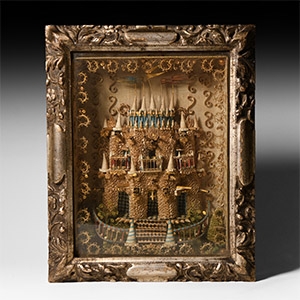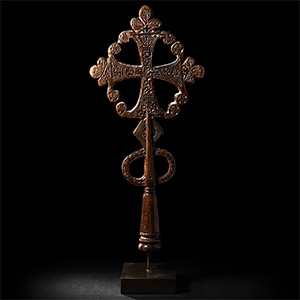A gold bifacial cruciform pendant comprising: outer frame of four lobes confining a cross moline with saltire to the centre, pierced lug to three arms each with a gold dangle, fourth with larger pierced tab for suspension. 1.59 grams, 21 mm
Acquired 1980-2015.
Ex Abelita family collection.
Sold for (Inc. bp): £1,950
A gilt silver chalice with bowl decorated with repoussé arcading, fluting and entwined motifs, balustered stem with ovoid centre adorned with pseud-architectural and leaf detailing, fluting below splaying out onto a circular foot bearing an applied oval armorial cartouche; interior base with foliate roundel in raised relief; dated 1589 in Roman numerals incised on the base. 309 grams, 13.5 cm high
English private collection.
A bronze discoid seal matrix with hinged flap to the reverse pierced near the edge; incuse heraldic design comprising a heater shield, helmet with foliage mantle and oak-tree crest; the shield with three fields (i) an empty tomb with cross potent emerging from the centre (ii) three cinquefoils (iii) two fish addorsed; concentric multilinear borders with legend in block capitals '· SEEL · IEAN · DV · BVISSON · 1617' (seal of Jean du Buisson) and scroll detail to the ends. 26.2 grams, 36 mm
The Matrix Collection, formed by David Morris since the late 1980s.
Matrix Collection catalogue no.5918.
Many of the seals within the collection were published in a book titled 'The Matrix Collection', by David Morris in 2012.
Accompanied by a copy of the illustrated collection notes.
Jean du Buisson, baron of Beauteville, married Jeanne de Lavenson de la Loubière in 1617 and died in 1634.
Sold for (Inc. bp): £8,450
A dynamic horse and mounted St George figure in wood; the helmetted rider with billowing cloak; gesso and polychrome; approximately half life-size; mounted on an elaborate custom-made display stand; repaired. 76 kg, 1.77 m high including stand
English private collection.
This lot has been checked against the Interpol Database of stolen works of art and is accompanied by search certificate no.11672-199837.
Likely derived from a religious scene.
The timber shows some old insect flight holes and we are advised that this piece has been recently treated with Permethrin, as a precaution.
Sold for (Inc. bp): £1,170
A bronze plaque displaying La Pietá in repoussé, in a wooden frame. 2.56 kg, 46.5 x 35.5 cm
English private collection.
Sold for (Inc. bp): £3,900
A naturalistic bronze female figure modelled standing contrapposto, nude, looking down towards her feet, one arm reaching over her head towards her neck, the other resting by her side, her weight placed on her right leg, hair tied into an elaborate bun with a ribbon, short ringlets falling down her nape and the end of the ribbon cascading over her shoulder, along the side of her right breast and down to her thigh, where she is holding the end; mounted on a custom-made display base. 754 grams, 20.5 cm high
English private collection.
With stylistic similarities to work by Giovanni Bologna; possibly Italian or Northern European.
A silver figure modelled in the round as Apostle Peter standing on a polygonal base, wearing a floor-length robe and clasping the key to the gate of Heaven to his breast, semi-naturalistic facial detailing, beard and hair. 50.13 grams, 65 mmFine condition.
Austrian private collection since circa 1995.
Ex central London gallery.
A silver figure modelled in the round as the Apostle Paul, standing on a polygonal base, wearing a voluminous floor-length robe, clasping the Bible to the right side of his breast, holding a sword in his left hand, semi-naturalistic detailing to his face, beard and hair. 58.2 grams, 66 mm highFine condition.
Austrian private collection since circa 1995.
Ex central London gallery.
Sold for (Inc. bp): £1,235
A wooden casket or reliquary with hand-made iron hinges, lock, hasp and other fittings; painted exterior in red with floral sprays, robed figure with advancing processional cross, robed nimbate figure with episcopal mitre, 'IHS' emblem to one end wall. 612 grams, 19 cm wideLock and one hinge broken.
English private collection.
A framed and glazed reliquary display box featuring a castle created from polychrome and gilt paper scrolls. 682 grams, 29 x 23.5 cm
English private collection.
A bifacial bronze Yämäṩor Mäsqäl processional cross finial with later replaced socket, flanking bird motifs and dense block of tendrils and wheels with seven cross-shaped finials, central panel with Virgin Mary, Holy Child and angels to the front, saints and Evangelists to the back. 55 grams, 26 cm (37.5 cm including stand)
Acquired on the London art market, 2006.
UK private collection.
Cf. Chojnacki, S., Major Themes in Ethiopian Painting, indigenous developments, the influence of foreign models and their adaptation, from the 13th to the 19th century, Wiesbaden, 1983, figs. 72-73; Chojnacki, S., Ethiopian Crosses, a Cultural History and Chronology, Milano, 2006, fig.83, for similar processional crosses.
In contrast with the hand cross that is fitted with a grip, the processional cross has a hollow shaft into which the pole supporting the cross is inserted, although the use of both is interconnected in the liturgy and ceremonial aspects of the Ethiopian Orthodox Church. In Amharic it received the name of yämäṩor mäsqäl or "cross to [carry] on a pole", the term mäṩor also meaning a wooden handle. Processional crosses are used on "every qaddase day" occasions - an expression meaning whenever the liturgy is performed. This includes displaying the cross during the reading of the Gospels and other sacred texts, as well as holding it up to be viewed at the end of the service for the final blessing.
A bifacial wooden Qäqwami Mäsqäl processional cross, three-lobed extremities on three sides, decorated with geometric motifs representing crosses of different types, supported by a lanceolate shaft with two round openwork openings; socketted shaft with vertical grooves and fitted with a double horizontal groove; inscriptions on two of the lobed sides of the cross; accompanied by a custom-made display stand. 600 grams, 42 cm high (49cm high including stand)
Acquired on the London art market, 2003.
UK private collection.
See Korabiewicz, W., The Ethiopian cross, Addis Ababa, 1973, fig.102, for similar.
The large wooden crosses are often used by ddbtdras, who are unordained members of the Orthodox Ethiopian clergy, for their liturgical dance. In the countryside, one or two of these crosses are kept on the church window-sills close to the area where the dance is performed, instead of being kept in the church storehouse. Sometimes they are mounted upon a shaft and worn in procession. The characteristic feature of a processional cross is a socketted shaft which serves for mounting them on a strong pole known as masor or handle. Although technically the shaft serves to support the cross, according to the interpretation of Ethiopian church scholars, its real function is to protect the cross from being touched.


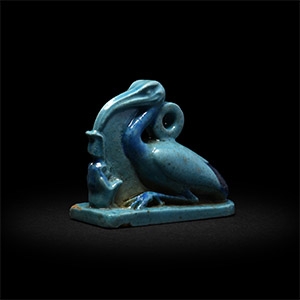



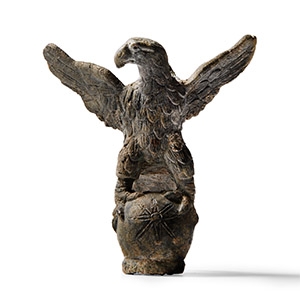
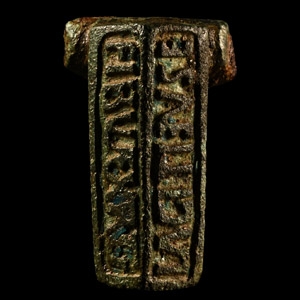

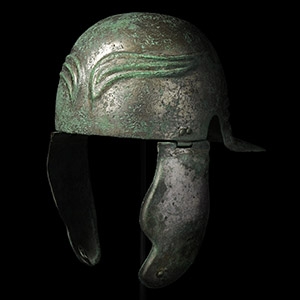
.jpg)
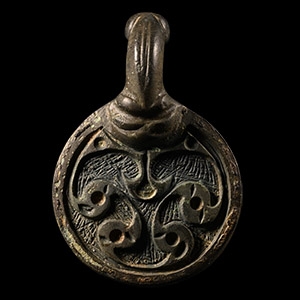
.jpg)
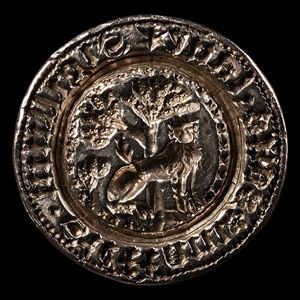
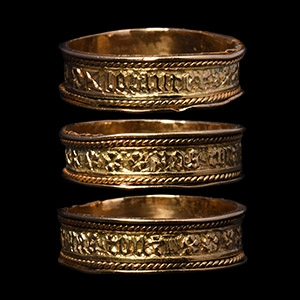


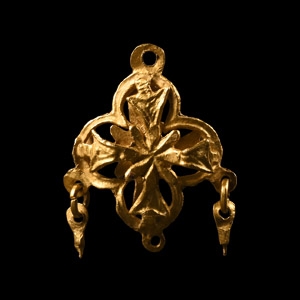
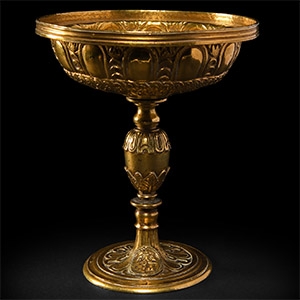


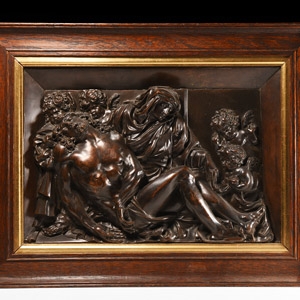
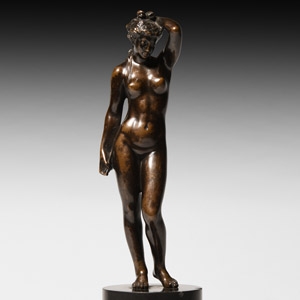
.jpg)
.jpg)

